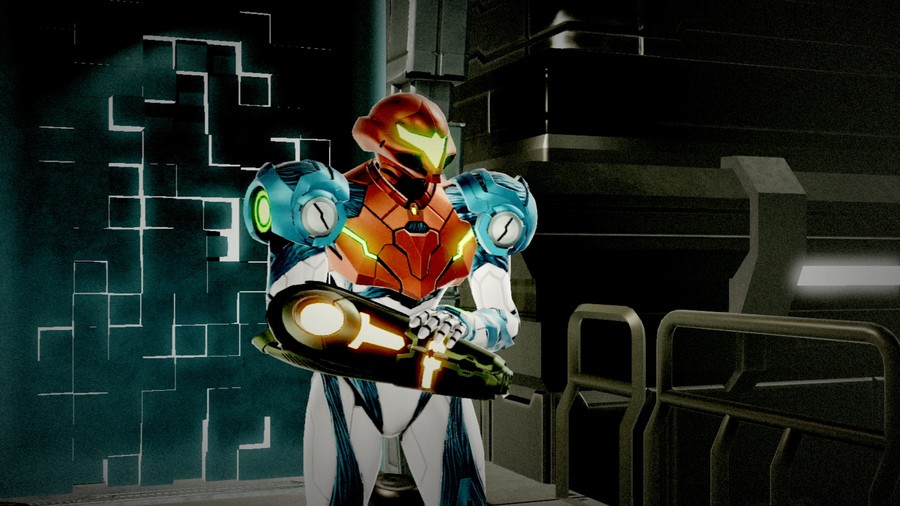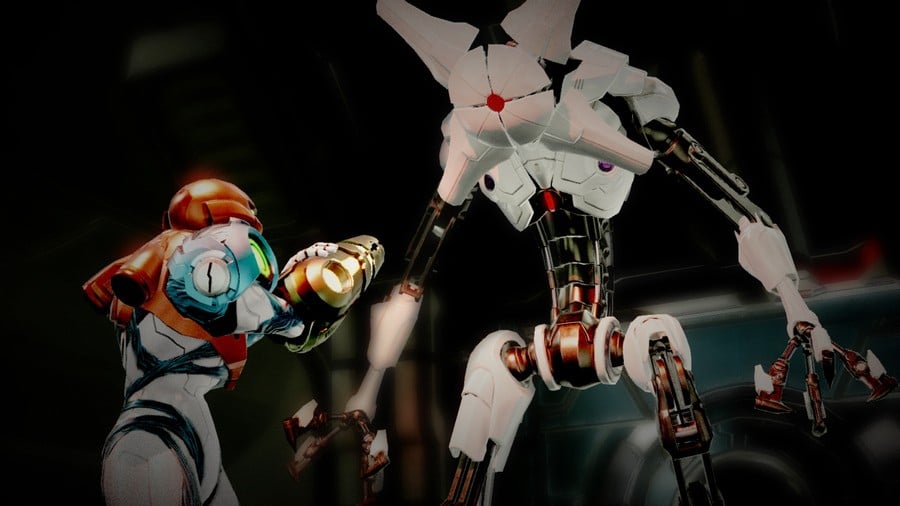“Samus Aran and her cool warrior persona, the exploration element, and the various elements of surprise.”
According to series overseer Yoshio Sakamoto, these tenets are the consistent components of any game that carries the name ‘Metroid’. As producer on the freshly announced Metroid Dread, the veteran Nintendo developer has guided the course of this action-exploration franchise for three-and-a-half decades now. Yes, incredibly, 2021 marks the 35th anniversary of Samus’ debut in the original Metroid for Famicom Disk System (and later NES).
“Her cool persona and integrity as a warrior has been a very important point for us to maintain and do justice to,” Sakamoto continued via an interpreter during a group Zoom Q&A session we attended the morning after the E3 reveal. It’s been 19 years since Metroid Fusion on the GBA, and this upcoming installment in the 2D adventures of the galaxy’s greatest bounty hunter is billed as a conclusion to a five-game series that includes the 8-bit original, plus Metroid II: Return of Samus on Game Boy (remade for 3DS by Spanish studio MercurySteam — more about them later), the sublime Super Metroid on SNES, the aforementioned Fusion, and now Dread.
The Past
The previous entry on GBA sacrificed the scale and grandeur of its home console predecessor for a more linear experience which suited shorter play sessions on that portable platform. According to Sakamoto, Metroid Dread will return to the more open approach of Super Metroid, and while the demo of the game we watched was largely limited to sections already showcased in the Nintendo Treehouse stream, it’s easy to see the influence of Super Metroid’s larger environments here.
Beginning in Artaria, the areas we’ve seen of Planet ZDR look rich, vibrant and varied. The condensing mist billowing over the platforms in the opening area, for example, add real texture to that cold metallic environment. The clean, hard edges of platforms visible upon destroying specific blast-able blocks — a staple of the franchise — stand out more than ever against from the textured splendor of the moodily lit surrounding area, but overall the increased visual fidelity of this Switch entry sets the tone very effectively.
While Sakamoto cites a return to the “more open” style of Super Metroid (yay!), MercurySteam’s first foray into the franchise — 2017’s 3DS remake of Metroid II — is the other major influence on Metroid Dread. That game’s defensive melee strike makes a return, but it’s supplemented here by a slide and dash melee which immediately opens up opportunities for a more aggressive playstyle, with much faster and combat than was possible in any previous 2D Metroid.
Following the success of Samus Returns, Sakamoto tells us that it was Nintendo which propositioned MercurySteam to partner up and revive this long-standing project. Despite the distance between Japan and the Spanish studio, not to mention the difficulties posed by the pandemic, Sakamoto spoke of how confident he felt in finding the right collaborator in MercurySteam, saying “we were perfectly in tune”.
The chronology and story elements of Dread were finalised relatively recently following the start of this partnership, and a recap ‘prologue’ of the story up to now (similar to the equivalent in Super Metroid) will bring newcomers — or players whose 2D Metroid lore might be a bit rusty after 20 years — up to speed.
The Present
Dread’s narrative might have only come into focus in this latest development phase, but the core concept of Samus encountering a ‘dreadful’ opponent remains from the project’s inception years ago. The “evolution of graphics” and the improved performance of modern consoles is what enabled the team to execute his original vision for the game, Sakamoto told the group. It’s a title that “inherits the core [concepts of the series]… but leverages all our past experience and learning up to now”.
The game is a 60FPS experience, so any frame counters out there can rest easy if you’ve only seen 30FPS footage online. As we watched the pre-Q&A demo, it was odd to think that this is the first high definition game in the series, and even at 30 FPS the smoothness of the experience manages to impress. That fluidity extends to movement and animation, too. We got a sense that this still has the heart of Metroid, but — in terms of flow and movement — it’s got some Dead Cells in its veins now, which will make getting around these environments just a little more fun than before.
A slower, more methodical style of play is certainly viable, and Sakamoto is keen to stress that great effort has gone into giving Dread a good balance between accessibility for newcomers and the challenge that series veterans expect, and that “the core of the game remains the same regardless of which Metroid game you play”. Good news for fans worried that this entry might deviate from the gameplay style they’ve grown to love over three-and-a-half decades, then. Still, it’s immediately obvious that Samus has never moved this slickly before, and the ability to really take the fight to enemies ‘on-the-fly’ looks to be a significant update to the more contemplative combat from previous games.
Not that your melee skills will be much help against the E.M.M.I., the white-panelled robotic enemies that patrol certain areas and hunt Samus if they sense her nearby. These machines might evoke the recent trend of Mr. X/Lady Dimitrescu-style ‘Terminators’ who can’t be dispatched by conventional means, but in practice the E.M.M.I. (or the ones we’ve seen so far) are more like watchdogs — a mashup of Breath of the Wild‘s possessed Guardians and a clambering General Grievious from Star Wars.
As they track you, a red ring around Samus’ waist indicates imminent danger unless you hightail it away, while yellow means they’ve heard you and they’re searching the vicinity. This visual feedback is elementary design, of course, but indicative of the thought and care put into making this game approachable while putting you “on edge”. Background elements such as orange thermal fuel pipes light up once activated and guide you through the level to your next destination, and you fill in your map in the same way as in previous games. Again, following coloured pipes through a stage is elementary game design, but invaluable to players with poor memories who might otherwise be overwhelmed by the sprawling levels and tension. Being pursued by the love child of General Grievous and a Portal turret is bound to disorientate you.
And despite the E.M.M.I. being positioned as the relentless ‘big bads’, they are vulnerable to weapons, just not Samus’ conventional complement. Temporarily charge up your arm cannon at a special station (which are obviously few and far between) and you’ll temporarily be able to take one down with a steady aim. It’s also possible to counter their (unexpectedly shocking) one-hit-kill attacks when they’ve got you pinned, although we’re told the counter timing differs on a per animation basis, so pulling it off and scrambling to safety will take some serious skill.
The audio adds another integral layer, with the E.M.M.I.s’ menacing ‘chirp’ instilling the eponymous dread effectively and the ambient soundtrack couples with the new visuals to deliver the series’ trademark tense atmosphere. Despite the relentless threat of the E.M.M.I., Sakamoto stresses that, in his opinion, this isn’t a “horror” game. The patrolling E.M.M.I. is just one element, with the series’ exploration and boss battles also present and correct.
Metroid Dread looks to be the ‘real deal’; a game from a team that knows this series inside out, a team who gets that despite a deluge of ‘Metroidvanias’, there’s still nothing quite like Metroid
It’s the same core, but with a slightly different ‘essence’, then. “I feel that you need to change a little bit of the essence […] to provide something new,” Sakamoto says. From the brief look we’ve had of the game — little more than you can see in the Treehouse videos, if we’re honest — we came away with the impression that Metroid Dread looks to be the ‘real deal’, so to speak; a game from a team that knows this series inside out, a team who gets that despite a deluge of quality ‘Metroidvania’-style games released in the intervening years, there’s still nothing quite like Metroid.
From what we’ve seen so far, at least, Metroid Dread earns that ‘5’ in its pre-title sequence.
The Future
That this new game is said to be a ‘conclusion’ to a 35-year-old story (with a “fitting ending” according to Sakamoto) puts a question mark on where the series — specifically the 2D branch — might go from here.
During the group Q&A, many questions proposed by attending journalists (which were then selected by Nintendo of Europe and relayed to Mr Sakamoto) were, as you’d expect, quite similar. Despite it being tough to know if our questions were being amalgamated with others, the phrasing of the final one posed to Sakamoto-san was definitely ours: This game is positioned as the ‘conclusion’ to a five-game story arc. What does that mean for potential future 2D Metroid games featuring Samus Aran?
“Samus’ adventure will continue,” Sakamoto replied. “And how it will continue? Well, first things first, I believe that when you clear Dread, you will have a clearer idea.”
Well, that the franchise would continue wasn’t in doubt, but it’s good to hear that this particular branch of the series has a future and that Samus will remain a part of it. As Sakamoto said at the top, the iconic bounty hunter and a sense of exploration and discovery are at the very core of the series. We’ve waited so long for Samus to return with a brand new 2D adventure; let’s cross our fingers that we don’t have to wait quite so long for the next one.
And as for Metroid Dread? It’s looking like it may actually be worth the two-decade wait. You can’t ask for more than that.


